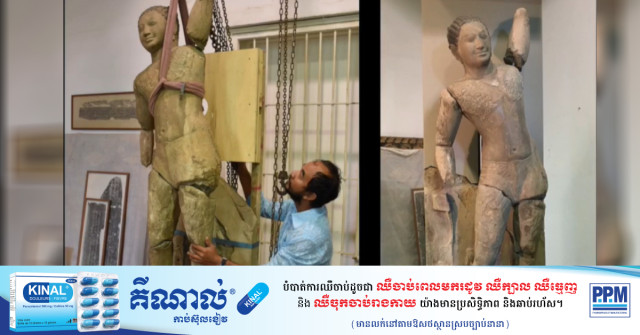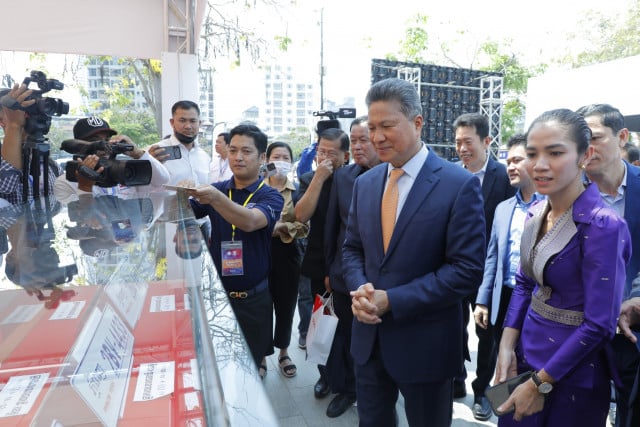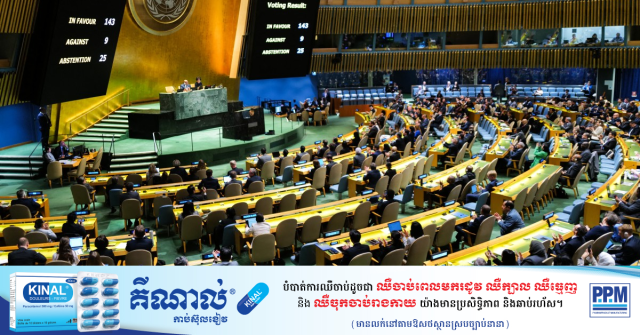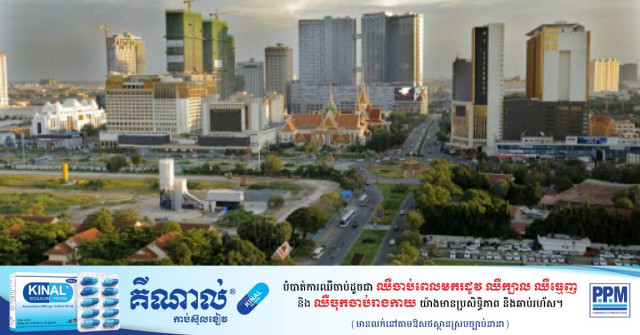The Tale of Two Krishnas: the Restoration of 1,500-year-old Statues on Two Continents Explained

- By Torn Chanritheara
- January 14, 2024 2:15 PM
PHNOM PENH — Two experts on Jan. 12 shed light on the restoration of two broken 1,500-year-old statues of the Hindu deity Krishna which, as they explained, has involved colossal work and, with the help of advanced technology, putting in their original places fragments that had been incorrectly reattached decades ago.
The statues named “Krishna Lifting Mount Govardhan” were discovered in the early 20th century in a temple located in a cave of Phnom Da mountain near the ancient capital city of Angkor Borei in what is now southern Takeo province. They depict a young Krishna.
One of the sculptures of this Hindu deity, which is at the National Museum of Cambodia in Phnom Penh, has been named the “Phnom Penh Krishna” while the other displayed at the Cleveland Museum of Arts in United States is referred to as the “Cleveland Krishna.”
During a public lecture on Jan. 12, Sonya Rhie Mace, curator of Indian and Southeast Asian art at the Cleveland Museum of Arts, and Bertrand Porte, a sculpture conservator from France’s École française d’Extrême-Orient (EFEO) who has been working with the National Museum restoration team for years in Phnom Penh, talked of what it took to bring together the various parts of the statues.
For years, the two Krishnas were mismatched fragments that had been assembled as well as could be since there was no technology to go further with the restoration. But techniques recently developed made it possible to match those fragments.
These two Krishna were among eight statues of the Phnom Da period (mid-6th to 8th centuries) that were found in one of the five manmade caves of Phnom Da temple, Porte said.
A Krishna statue was first found in 1911 by French archeologist Henry Parmentier, he said. Since the statue had no leg or arm and was only supported by a stele, it was very difficult to say for certain that it was a statue of Krishna, he said.
 Left, a restoration expert of the Cleveland Museum of Arts scans the statue of Khrisna exhibited at the museum. Right, a 3D laser scan of a section of the statue of Krishna at the National Museum in Phnom Penh was loaned to the Metropolitan Museum of Art in New York City in 2014. Photo captured online during the National Museum conference on Jan. 12, 2024.
Left, a restoration expert of the Cleveland Museum of Arts scans the statue of Khrisna exhibited at the museum. Right, a 3D laser scan of a section of the statue of Krishna at the National Museum in Phnom Penh was loaned to the Metropolitan Museum of Art in New York City in 2014. Photo captured online during the National Museum conference on Jan. 12, 2024.
The Phnom Penh Krishna
In 1944, a torso of a Krishna statue was brought by Kam Doum, an officer in charge, to the National Museum in Phnom Penh, Porte said. With so many parts missing, it was difficult to figure out the position of the statue, he said.
“We guessed as it is a movement of the body but since it is missing arm and leg, it was difficult to find the right position,” Porte said. Still, until 1998, the torso of the Krishna statue was exhibited as it was at the National Museum.
However that year, the sandstone statue was the object of a dedicated intervention in the museum restoration workshop, Porte said. Its face and chest were paid special attention as there was a mark on the face of the statue and previous restoration efforts had not been done well, he said.
But the position of the statue remained a mystery, Porte said.
In 2005, the Cleveland Museum of Arts (CMA) sent to the National Museum nine fragments that had been collected by EFEO archeologist Henri Mauger in 1936. The fragments had been in Belgium before being sent to CMA in the 1970s for the restoration of the second Krishna statue. While these pieces were believed to have been correctly attached to the “Cleveland Krishna,” they actually belonged to the “Phnom Penh Krishna” of the National Museum, Porte said.
Upon receiving the fragments from CMA in 2005, the museum restoration team went to work, starting with two arms and a thigh being attached to the body of the Krishna statue. The upper stele that linked to the left arm was also affixed on the statue but it could not be accurately attached even though it looked as if it was, Porte said.
“It was decided to present the statue this way as it makes much more sense,” he said, adding that the Krishna was now starting to appear as if he was standing.
In December 2005, the right forearm was found in the museum’s storage area and was assembled with the statue.
Following the reassembling operation, the Phnom Penh Krishna was sent on a world tour, which included being exhibited at the Kunstmuseum Bonn in Germany in 2007-2008, and the Metropolitan Museum of Art in New York City in 2014.
It was before the exhibition in New York that Porte and Rhie Mace discussed the Krishna of the Cleveland Museum of Arts and later on conducted research on the restoration. They soon realized that the upper stele of the Phnom Penh Krishna perfectly fitted the Cleveland Krishna, Porte said. The stele was later sent to CMA for reassembly work.
However, the Phnom Penh Krishna could no longer be displayed in the National Museum since the torso could not stand without the stele. In 2018, the restoration team tried to come up with a solution for the statue. As he and Sok Soda of the museum’s restoration team were looking into building a stele to support the statue and were comparing photos of the two statues, they realized that the right hip and base of the Cleveland Krishna in fact belonged to the Phnom Penh Krishna.
As they were preparing the exhibition “Revealing Krishna: Journey to Cambodia’s Sacred Mountain,” CMA sent these fragments to the National Museum in Phnom Penh.
And so, the work to reassemble those pieces with Phnom Penh Krishna began in 2021. “It’s hard and quite complex to install a heavy torso and two fragile legs,” Porte explained. Support material had to be attached to maintain the statue in a standing position, he said.
 Sonya Rhie Mace of the Cleveland Museum of Arts and Bertrand Porte of the EFEO who works with the National Museum restoration team in Phnom Penh are shown during the conference. Photo captured online during the National Museum conference on Jan. 12, 2024.
Sonya Rhie Mace of the Cleveland Museum of Arts and Bertrand Porte of the EFEO who works with the National Museum restoration team in Phnom Penh are shown during the conference. Photo captured online during the National Museum conference on Jan. 12, 2024.
The Cleveland Krishna
“The Krishna of Phnom Da is the most important and most famous work of art in the Asian collection of our museum,” Sonya Rhie Mace said.
The Cleveland Krishna arrived at the museum in 1973—having been purchased from a collector—and much like its twin Krishna in Phnom Penh, there was no leg and arm: It was just a torso.
In 1977, 17 fragments of statues from the Phnom Da site were found in a garden in Belgium and sent to Cleveland by a former museum curator. One year later, the restoration team of the Cleveland Museum of Arts (CMA) reassembled the fragments with the body.
At the time, there was no way to communicate with colleagues in Cambodia, Rhie Mace said. “So, the restoring team did the best they could without knowing anything about the other Krishna,” she said.
In 2014, Rhie Mace came to the National Museum in Phnom Penh to do research on a statue of Hanuman. During her visit, Porte told her that he had doubts regarding the upper stele connected to the body of the Phnom Penh Krishna. This led to 3D scans being done on the Cleveland Krishna and in 2014 on the Phnom Penh Krishna when it was brought to New York for an exhibition.
“When we digitally joined the pieces together, we could see the hand [on the upper stele of the Phnom Penh Krishna] could work well with the body of the Cleveland Krishna,” Rhie Mace said.
In 2015, the stele was sent to the CMA. In October, the upper stele with hand arrived in Cleveland and a printout in lightweight plastic was made to try the pieces together. Porte also traveled to the United States to inspect the work.
However, a problem arose. The feet were in the wrong position. It took the CMA team two years to take apart the old restoration work and remedy the situation.
An exhibition was held to show how difficult the restoration of the two Krishnas had been, with the two Krishna statues standing side by side in a display area equipped with technology storytelling features.
Through sound, video and visual, the exhibition showed the journey of the human-size Krishna statues, the cave of Phnom Da where they were found, and the Phnom Da temple located in today’s Takeo Province.
 The Cleveland Museum of Arts produced in virtual reality an image of the Cleveland Krishna statue as it might have stood in a cave of Phnom Da mountain where it was found in Cambodia. Photo captured online during the National Museum conference on Jan. 12, 2024.
The Cleveland Museum of Arts produced in virtual reality an image of the Cleveland Krishna statue as it might have stood in a cave of Phnom Da mountain where it was found in Cambodia. Photo captured online during the National Museum conference on Jan. 12, 2024.
 Krishna statues are standing side by side in a display area at the Cleveland Museum of Arts. Photo captured online during the National Museum conference on Jan. 12, 2024.
Krishna statues are standing side by side in a display area at the Cleveland Museum of Arts. Photo captured online during the National Museum conference on Jan. 12, 2024.

















